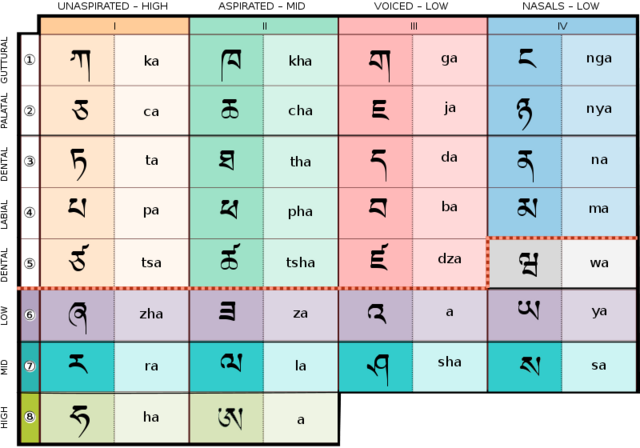Tibetan Grammar - Formation of the Tibetan Syllable
WORK IN PROGRESS: the grammar articles are being edited for wiki publication. During editing, the content might be incomplete, out of sequence or even misleading.
| Articles on Tibetan Grammar |
| 1. Introduction |
| 2. Formation of the Tibetan Syllable |
| 3. Formation of the Tibetan Word |
| 4. First case: ming tsam |
| 5. agentive particle |
| 6. Connective Particle |
| 7. La don particles |
| 8. La don particles—Notes |
| 9. Originative case |
| 10. Verbs |
| 11. Verbs—Notes |
| 12. Syntactic particles |
by Stefan J. E.
Formation of the Tibetan syllable
Overview
The Tibetan alphabet

Tibetan names of the components of a syllable
| དབྱངས་༼ཨི་ཨེ་ཨོ་༽ vowel (i, e, o) | ||||
| མགོ་ཡིག་ superscribed letter | ||||
| སྔོན་འཇུག་ prefix letter |
མིང་གཞི་ root letter |
རྗེས་འཇུག་ postfix letter |
ཡང་འཇུག་ second postfix letter |
ཚེག་ dot |
| འདོགས་ཡིག་ subscribed letter | ||||
| དབྱངས་༼ཨུ་༽ vowel (u) |
Letters that are used for the different components of a syllable
| Position | Letter |
| Root letter, མིང་གཞི་ | the whole alphabet except for the vowels i, u, e, o which need ཨ་ or འ་ as a "vowel-carrier" |
| Prefix letters, སྔོན་འཇུག་ | ག་ ད་ བ་ མ་ འ་ |
| Superscribed letters, མགོ་ཡིག་ | ར་ ལ་ ས་ |
| Subscribed letters, འདོགས་ཡིག་ | ཡ་ ར་ ལ་ ཝ་ |
| Suffix letters, རྗེས་འཇུག་ | ག་ ང་ ད་ ན་ བ་ མ་ འ་ ར་ ལ་ ས་ |
| second suffix letters, ཡང་འཇུག་ | ས་ ད་ |
Examples
- བདག་
| བ སྔོན་འཇུག་ prefix letter |
ད མིང་གཞི་ root letter |
ག རྗེས་འཇུག་ postfix letter |
་ ཚེག་ dot |
- ཀྱང་
| ཀ མིང་གཞི་ root letter |
ང རྗེས་འཇུག་ postfix letter |
་ ཚེག་ dot |
| ྱ འདོགས་ཡིག་ subscribed letter |
- བསྒྲུབས་
| ས མགོ་ཡིག་ superscribed letter | ||||
| བ སྔོན་འཇུག་ prefix letter |
ག མིང་གཞི་ root letter |
བ རྗེས་འཇུག་ postfix letter |
ས ཡང་འཇུག་ second postfix letter |
་ ཚེག་ dot |
| ྲ འདོགས་ཡིག་ subscribed letter | ||||
| ུ དབྱངས་༼ཨུ་༽ vowel (u) |
- དབྱིངས་
| ི དབྱངས་༼ཨི་ཨེ་ཨོ་༽ vowel (i, e, o) | ||||
| ད སྔོན་འཇུག་ prefix letter |
བ མིང་གཞི་ root letter |
ང རྗེས་འཇུག་ postfix letter |
ས ཡང་འཇུག་ second postfix letter |
་ ཚེག་ dot |
| ྱ འདོགས་ཡིག་ subscribed letter |
Combinations of letter forming a syllable
Vowels
- i ི e ེ o ོ are written above the root letter.
- u ུ is written below the root letter.
E.g.:
- ལ་ + ི = ལི་
- ང་ + ུ = ངུ་
- མ་ + ེ = མེ་
- ཁ་ + ོ = ཁོ་
Subscribed letters
Subscribed letters, འདོགས་ཡིག་: ཡ་ ར་ ལ་ ཝ་
| Position | Letter |
| ཡ་ is used under and becomes ྱ |
ཀ་ ཁ་ ག་ པ་ ཕ་ བ་ མ་ རྐ་ རྒ་ རྨ་ སྐ་ སྒ་ སྤ་ སྦ་ སྨ་ ཀྱ་ ཁྱ་ གྱ་ པྱ་ ཕྱ་ བྱ་ མྱ་ རྐྱ་ རྒྱ་ རྨྱ་ སྐྱ་ སྒྱ་ སྤྱ་ སྦྱ་ སྨྱ་ |
| ར་ is used under and becomes ྲ |
ཀ་ ཁ་ ག་ ཏ་ ཐ་ ད་ པ་ ཕ་ བ་ མ་ ཤ་ ས་ ཧ་ སྐ་ སྒ་ སྤ་ སྦྲ་ སྨ་ སྣ་ ཀྲ་ ཁྲ་ གྲ་ ཏྲ་ ཐྲ་ དྲ་ པྲ་ ཕྲ་ བྲ་ མྲ་ ཤྲ་ སྲ་ ཧྲ་ སྐྲ་ སྒྲ་ སྤྲ་ སྦྲ་ སྨྲ་ སྣྲ་ * |
| ལ་ is used under and does not change |
ཀ་ ག་ བ་ ཟ་ ར་ ས་ ཀླ་ གླ་ བླ་ ཟླ་ རླ་ སླ་ |
| ཝ་ is used under and becomes ྭ |
ཀ་ ཁ་ ག་ ཅ་ ཉ་ ཏ་ ད་ ཙ་ ཚ་ ཞ་ ཟ་ ར་ ལ་ ཤ་ ས་ ཧ་ གྲ་ དྲ་ ཕྱ་ རྒ་ རྩ་ ཀྭ་ ཁྭ་ གྭ་ ཅྭ་ ཉྭ་ ཏྭ་ དྭ་ ཙྭ་ ཚྭ་ ཞྭ་ ཟྭ་ རྭ་ ལྭ་ ཤྭ་ སྭ་ ཧྭ་ གྲྭ་ དྲྭ་ ཕྱྭ་ རྒྭ་ རྩྭ་ ** |
- * Some of them are rare, for example, in the Great Tibetan-Chinese Dictionary, བོད་རྒྱ་ཚིག་མཛོད་ཆེན་མོ་ there are only three syllables with སྣྲ.
- ** All of them are rare, many of them very rare.
Changes in tone, aspiration and pronunciation with subscribed letters
- Subscribed letters don’t cause any changes in tone and / or aspiration.
Subscribed ཡ་, ཡ་བཏགས་
- ཀྱ་, རྐྱ་, སྐྱ་, are pronounced
/kya/, high tone - ཁྱ་, is pronounced
/khya/, high tone - གྱ་, is pronounced
/khya/, low tone
[...]
Endnotes
- ↑ From: Wikimedia commons, http://en.wikipedia.org/wiki/File:Tibetan_script.svg